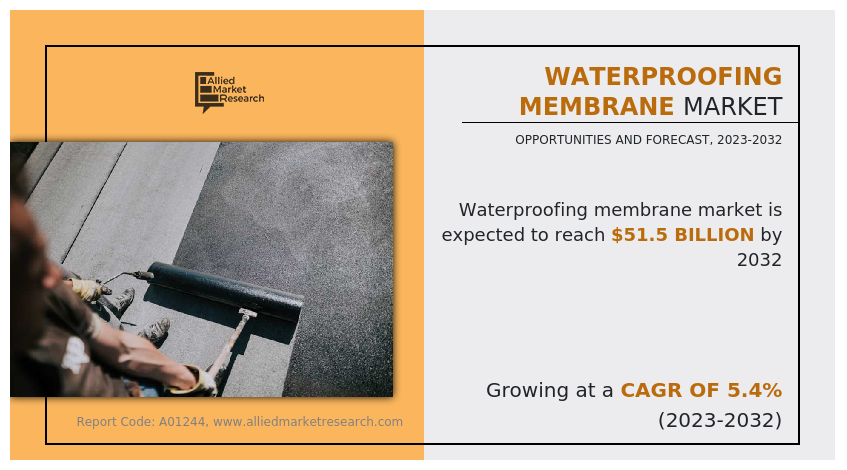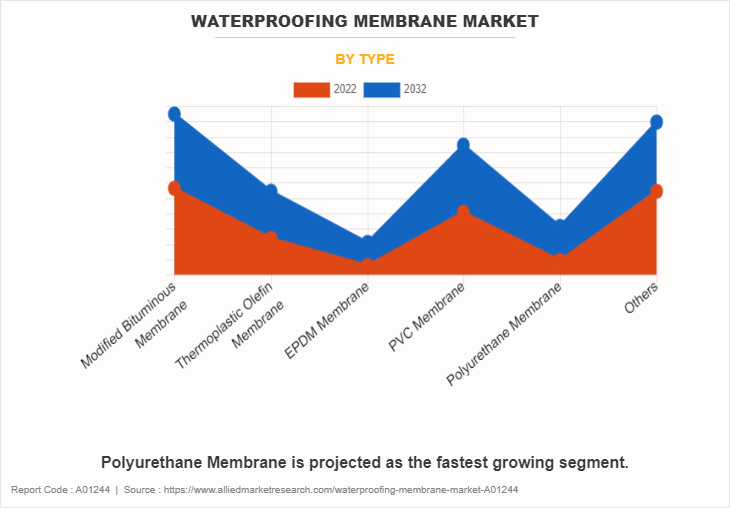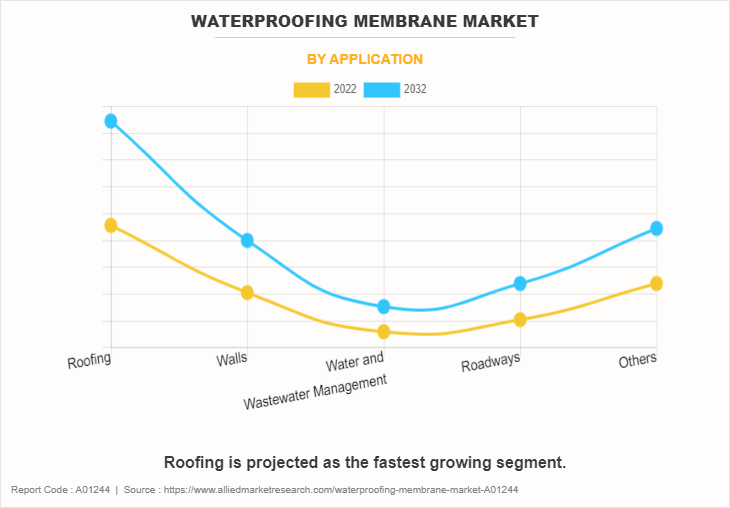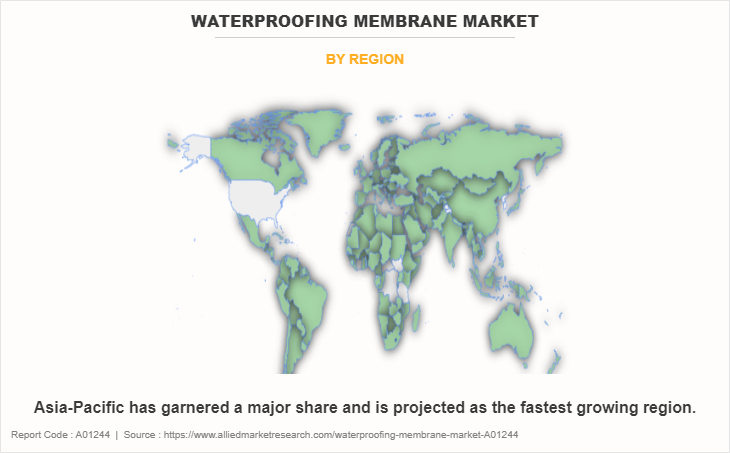Waterproofing Membrane Market Research, 2032
The global waterproofing membrane market was valued at $31.0 billion in 2022 and is projected to reach $51.5 billion by 2032, growing at a CAGR of 5.4% from 2023 to 2032. Rise in investments in the building sector and increased use of waterproofing membranes in mining are fueling the growth of the waterproofing membrane industry. Enhanced construction projects and the need for reliable moisture protection in mining operations drive demand for advanced waterproofing solutions. These factors contribute to the industry's expansion as both sectors seek durable and effective waterproofing materials to address their specific needs.

Waterproofing membranes are thin layers of material used to prevent water penetration into structures such as buildings, bridges, and tunnels. These membranes are typically made from water-light material such as bitumen, rubber, or plastic, and they are applied to surfaces to create a barrier that keeps water out. They are commonly used in areas prone to water damage, such as basements, roofs, and foundations. Waterproofing membranes have several properties that make them effective, including flexibility, durability, and resistance to UV rays and chemicals. They are also easy to install and maintain, making them a popular choice for waterproofing applications.
Key Takeaways:
- Quantitative information mentioned in the global waterproofing membrane market forecast includes the market numbers in terms of value ($Million) volume (Million Square Meter) concerning different segments, pricing analysis, annual growth rate, CAGR (2023-32), and growth analysis.
- The analysis in the report is provided based on type, application, and region. The study is expected to contain qualitative information such as the market dynamics (drivers, restraints, opportunities), Porter’s Five Force Analysis, key regulations across the region, and value chain analysis.
- A few companies, including Soprema Group, KÖSTER BAUCHEMIE AG, Johns Manville, Sika AG, Kemper System America, Inc., hold a large proportion of the waterproofing membrane market.
- This report makes it easier for existing market players and new entrants to the waterproofing membrane industry to plan their strategies and understand the dynamics of the industry, which helps them make better decisions.
Market Dynamics:
Waterproofing membranes are utilized in roofing and construction walls due to their great tensile strength and weather resistance. In addition, they help improve flow resistance at high temperatures and offer fire resistance. In the Middle East and Asia-Pacific, there is a growing need for waterproofing membranes for use in wall and roofing applications. Its primary cause is the rise in initiatives involving commercial infrastructure in these areas. The popularity of PVC roofing systems has increased recently because of many unique qualities, such as their long lifespan, resilience to extreme weather and temperature changes, low lifecycle costs, energy efficiency, heat and solar reflectance, flame resistance, chemical and grease resistance, ease of maintenance, flexibility in installation, and inherent recyclability or repurposing, among many other benefits.
According to the Ministry of Housing, Communities, and Local Government (UK), the number of new housing units in the UK increased from 41,600 in Q4 2021 to 42,350 in Q1 2022. In addition, a recent House of Commons report released in 2022 states that the number of households in England is projected to rise steadily to 26.9 million units by 2043, representing an increase of almost 150,000 households per year.
According to the Bureau of Economic Analysis, the total value generated by the construction industry in the first three quarters of 2022 in the U.S. was around $2,980 billion, or roughly 5% more than the previous year for the same time. In February 2022, the Manchester City Council approved a nine-year development project for four skyscrapers. Under this project, residential buildings with 39–60 floors will be built on the Trinity Islands, which are the banks of the River Irwell. The project is expected to involve building 1,950 apartments. These factors together with growing investments in the building sector suggest that waterproofing walls and roofs is becoming more important in residential and commercial buildings, which will fuel demand for waterproofing membrane market size during the forecast period.
The mining sector is one of the most demanding industries when it comes to protecting infrastructure and equipment from water damage. Waterproofing membranes play a crucial role in ensuring the longevity and efficiency of mining operations by preventing water infiltration into structures, tunnels, and equipment. As the mining industry continues to expand globally, the demand for waterproofing membranes is expected to increase significantly. This growth is driven by several factors, including the need to extend the lifespan of mining infrastructure, comply with environmental regulations, and improve safety standards.
In addition, a rise in mining operations and increased investments in the mining industry are expected to drive waterproofing membrane market growth expansion over the forecast period. The International Energy Agency (IEA) projects that global investments in the coal supply chain will amount to $115 billion by 2022. It is projected that $80 billion will be invested by China and India. China and India were the world's two biggest producers of coal in 2021. In these two countries, thermal power generation still makes up more than 80% of the total power generation capacity. As a result, manufacturers of waterproofing membranes are expected to see a surge in demand from the mining sector, leading to an expansion of the market share.
The waterproofing membrane market faces several challenges that hamper its growth, including regulatory compliance issues and fluctuating raw material costs. Regulatory compliance is a significant challenge for waterproofing membrane manufacturers, as they must adhere to various regulations and standards set by governments and industry organizations. These regulations can be complex and vary from country to country, making it difficult for manufacturers to ensure compliance. Failure to comply with regulations can result in fines, legal action, and damage to a company's reputation. Another challenge for the waterproofing membrane market is fluctuating raw material costs. The cost of raw materials, such as polymers and additives, can fluctuate due to factors such as changes in supply and demand, currency fluctuations, and geopolitical events. These fluctuations can impact a manufacturer's profitability and ability to compete in the market. In addition, manufacturers may struggle to pass on increased costs to customers, leading to lower profit margins.
In addition to these challenges, the waterproofing membrane market is also facing increased competition from alternative products, such as liquid-applied membranes and sheet membranes. These products offer advantages such as ease of installation and lower cost, which can make them more attractive to customers. As a result, manufacturers of traditional waterproofing membranes must innovate and differentiate their products to remain competitive.
The rising awareness of environmental sustainability has led to a growing demand for waterproofing membranes in various industries. Waterproofing membranes are used to protect structures from water damage, which can lead to costly repairs and environmental degradation. As the world becomes more conscious of the impact of construction and other industries on the environment, the demand for sustainable waterproofing solutions is expected to increase. This presents a lucrative opportunity for the growth of the waterproofing membrane market. Companies that can offer eco-friendly and sustainable waterproofing solutions are expected to see increased demand for their products. In addition, as regulations and standards for environmental sustainability become more stringent, companies that can provide waterproofing membranes that meet these requirements will have a competitive advantage. Overall, the rising awareness of environmental sustainability is expected to drive the growth of the market, creating opportunities for companies that can offer innovative and sustainable solutions.
Segment Overview:
The waterproofing membrane market is segmented based on type, application, and region. By type, the market is divided into modified bituminous membrane, thermoplastic olefin membrane, EPDM membrane, PVC membrane, polyurethane membrane, and others. By application, it is categorized into roofing, walls, water and wastewater management, roadways and others. Region-wise, the market is studied across North America, Europe, Asia-Pacific, and LAMEA.

Waterproofing Membrane Market, By Segment
The modified bituminous membrane segment accounted for the largest share in 2022. These membranes offer superior waterproofing properties compared to traditional materials, making them a preferred choice for various construction projects. Secondly, the growing construction industry, especially in developing countries, is driving the demand for waterproofing solutions. In addition, the increasing awareness about the benefits of using modified bituminous membranes, such as their durability and ease of installation, is also contributing to their rising demand in the market.
Polyurethane membrane is expected to register the highest CAGR of 5.9%. Polyurethane membranes are in high demand in the waterproofing membrane market due to several factors. They offer superior waterproofing properties compared to traditional materials like bitumen. They are lightweight and easy to install, making them a popular choice for construction projects. In addition, polyurethane membranes are highly durable and can withstand harsh weather conditions, making them ideal for outdoor applications. Furthermore, they are also environmentally friendly and can be recycled, which is a growing concern for many consumers.

Waterproofing Membrane Market, By Application
The roofing segment accounted for the largest share in 2022 and is expected to register the highest CAGR of 5.6%. Several factors contribute to the increasing demand for roofing applications in the waterproofing membrane market. One factor is the growing awareness of the importance of protecting buildings from water damage. As people become more aware of the risks associated with water damage, they are more likely to invest in waterproofing solutions for their roofs. In addition, the increasing frequency of extreme weather events, such as heavy rainfall and hurricanes, has led to an increased demand for waterproofing membranes that can withstand these conditions. Furthermore, the construction industry is experiencing a period of growth, which is driving demand for waterproofing solutions for new buildings and renovations.

Waterproofing Membrane Market, By Region
Asia-Pacific garnered the largest share in 2022. The demand for waterproofing membranes in the Asia-Pacific region is increasing due to several factors. The region is experiencing rapid urbanization and industrialization, leading to a higher demand for waterproofing solutions in construction projects.The International Trade Administration predicts a consistent 8.6% average growth rate in China's construction sector from 2022 to 2030. In addition, the Make in India campaign, by the Government of India, aims to achieve infrastructural investments totaling $965.5 million 2040.
In addition, the increasing frequency of extreme weather events, such as heavy rainfall and flooding, is driving the need for more robust waterproofing systems. Furthermore, the growing awareness of the importance of sustainable construction practices is also contributing to the demand for waterproofing membranes, as they can help improve energy efficiency and reduce the environmental impact of buildings.The Asian Development Bank (ADB) pledged $100 million in funding for India's infrastructure sector through the government-backed National Investment and Infrastructure Fund (NIIF). Foreign investments play a pivotal role in India's efforts to revamp its infrastructure, encompassing ports, airports, and highways, thereby stimulating economic growth. Infrastructure stands out as one of the primary sectors attracting substantial foreign direct investment (FDI). Initiatives like 'Housing for all' and the 'Smart Cities Mission' have notably benefited from such inflows.
Competitive Analysis:
The major players operating in the global waterproofing membrane market are Soprema Group, KÖSTER BAUCHEMIE AG, Johns Manville, Sika AG, Kemper System America, Inc., Danosa, Minerals Technologies Inc., HOLCIM, Dow, and Isomat S.A.
These key players adopted strategies such as Sika acquired United Gilsonite Laboratories (UGL) in the U.S., a well-recognized manufacturer of products for consumer and DIY waterproofing applications. This acquisition complemented Sika's high-value-added concrete and masonry waterproofing systems and boosted the demand for the waterproofing membrane market.
Holcim acquired Quimexur, a leading producer of liquid membranes for roofing and waterproofing applications in Argentina. This acquisition expanded the roofing and waterproofing solutions in Latin America and boosted the demand for the waterproofing membrane market.
Holcim acquired PASA, a leading producer of roofing and waterproofing solutions in Mexico and Central America. This acquisition expanded Holcim's roofing and waterproofing, strengthened its business footprint in the region, and thus, boosted the demand for the waterproofing membrane market.
Public Policies:
ASTM International: ASTM has developed numerous standards related to waterproofing membranes, including ASTM D1227 (Standard Specification for Emulsified Asphalt Used as a Protective Coating for Roofing) and ASTM D1079 (Standard Specification for Gypsum Roof Decking).
American National Standards Institute (ANSI): ANSI has developed standards such as ANSI/SPRI ES-1 (Wind Design Standard for Edge Systems Used with Low Slope Roofing Systems) and ANSI/SPRI RP-4 (Wind Design Guide for Ballasted Single-ply Roofing Systems).
Key Benefits For Stakeholders:
- This report provides a quantitative analysis of the market segments, current trends, estimations, and dynamics of the waterproofing membrane market analysis from 2022 to 2032 to identify the prevailing the market opportunities.
- The market research is offered along with information related to key drivers, restraints, and opportunities.
- Porter's five forces analysis highlights the potency of buyers and suppliers to enable stakeholders make profit-oriented business decisions and strengthen their supplier-buyer network.
- In-depth analysis of the waterproofing membrane market segmentation assists to determine the prevailing market opportunities.
- Major countries in each region are mapped according to their revenue contribution to the global market.
- Market player positioning facilitates benchmarking and provides a clear understanding of the present position of the market players.
- The report includes the analysis of the regional as well as global waterproofing membrane market trends, key players, market segments, application areas, and market growth strategies.
Analyst Review
According to insights from CXOs of leading companies, rise in demand for waterproofing membranes across industries like construction, infrastructure, and civil engineering is driving significant market growth. Waterproofing membranes are essential for protecting structures from water damage, and their high durability, resistance to chemicals, and flexibility make them a preferred choice for a variety of applications. In addition, the growing focus on sustainable building practices has led to the development of eco-friendly waterproofing solutions, aligning with the global trend toward greener construction materials.
However, the market faces challenges due to fluctuating cost of raw materials, particularly polymers and bitumen, which are vital components in membrane production. These price fluctuations, often tied to oil prices, impact manufacturing costs and product pricing, constraining market expansion.
CXOs also noted that the rapid development of urban infrastructure, driven by megaprojects such as smart cities and high-rise buildings, offers substantial growth potential for waterproofing membranes. Furthermore, increase in need for robust waterproofing solutions in sectors like wastewater treatment and tunnels presents lucrative opportunities for the market growth.
Waterproofing Membrane Market Report Highlights
| Aspects | Details |
| Market Size By 2032 | USD 51.5 billion |
| Growth Rate | CAGR of 5.4% |
| Forecast period | 2022 - 2032 |
| Report Pages | 389 |
| By Type |
|
| By Application |
|
| By Region |
|
| Key Market Players | Soprema Group., Johns Manville, Minerals Technologies Inc., KOSTER BAUCHEMIE AG, Sika AG, Dow Inc., HOLCIM, Isomat S.A., Danosa, Kemper System America, Inc. |
| | Paul Bauder GmbH & Co. KG, CICO Technologies Ltd., Fosroc Ltd, GAF Materials Corporation, Alchimica Building Chemicals, Maris Polymers, Isomat S.A. |
Roofing is the leading application of Waterproofing Membrane Market.
Soprema Group, KÖSTER BAUCHEMIE AG, Johns Manville, Sika AG, Kemper System America, Inc., are the top companies to hold the market share in Waterproofing Membrane.
Growth in popularity of green roofs is the upcoming trend of Waterproofing Membrane Market in the world.
The waterproofing membrane market is segmented into type, application, and region. By type, the market is divided into modified bituminous membrane, thermoplastic olefin membrane, EPDM membrane, PVC membrane, polyurethane membrane, and others. By application, it is categorized into roofing, walls, water and wastewater management, roadways and others. Region-wise, the market is studied across North America, Europe, Asia-Pacific, and LAMEA.
The global waterproofing membrane market was valued at $31.0 billion in 2022 and is projected to reach $51.5 billion by 2032, growing at a CAGR of 5.4% from 2023 to 2032.
Asia-Pacific is the largest regional market for Waterproofing Membrane.
Loading Table Of Content...
Loading Research Methodology...



